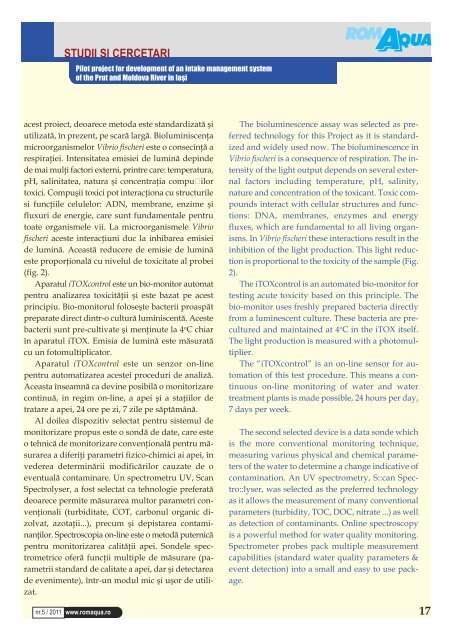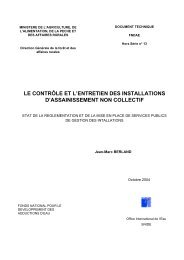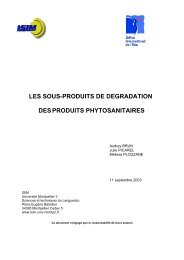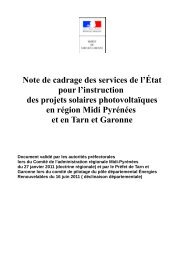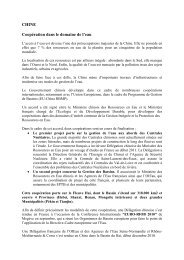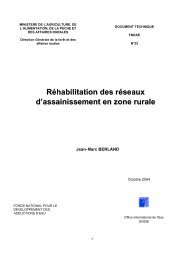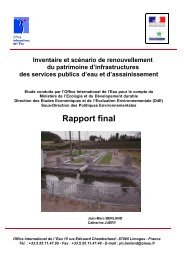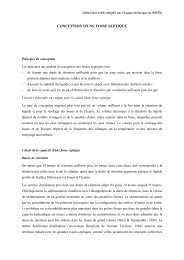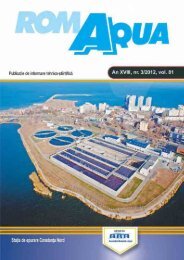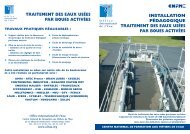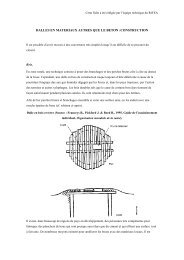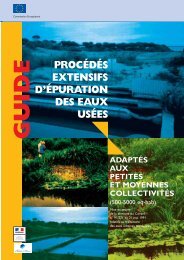vol 77 n° 5 2011 - Office International de l'Eau
vol 77 n° 5 2011 - Office International de l'Eau
vol 77 n° 5 2011 - Office International de l'Eau
You also want an ePaper? Increase the reach of your titles
YUMPU automatically turns print PDFs into web optimized ePapers that Google loves.
STUDII SI CERCETARI<br />
Pilot project for <strong>de</strong>velopment of an intake management system<br />
of the Prut and moldova river in iaşi<br />
acest proiect, <strong>de</strong>oarece metoda este standardizată şi<br />
utilizată, în prezent, pe scară largă. Bioluminiscenţa<br />
microorganismelor Vibrio fischeri este o consecinţă a<br />
respiraţiei. Intensitatea emisiei <strong>de</strong> lumină <strong>de</strong>pin<strong>de</strong><br />
<strong>de</strong> mai mulţi factori externi, printre care: temperatura,<br />
pH, salinitatea, natura şi concentraţia compuilor<br />
toxici. Compuşii toxici pot interacţiona cu structurile<br />
si funcţiile celulelor: ADN, membrane, enzime şi<br />
fluxuri <strong>de</strong> energie, care sunt fundamentale pentru<br />
toate organismele vii. La microorganismele Vibrio<br />
fischeri aceste interacţiuni duc la inhibarea emisiei<br />
<strong>de</strong> lumină. Această reducere <strong>de</strong> emisie <strong>de</strong> lumină<br />
este proporţională cu nivelul <strong>de</strong> toxicitate al probei<br />
(fig. 2).<br />
Aparatul iTOXcontrol este un bio-monitor automat<br />
pentru analizarea toxicităţii şi este bazat pe acest<br />
principiu. Bio-monitorul foloseşte bacterii proaspăt<br />
preparate direct dintr-o cultură luminiscentă. Aceste<br />
bacterii sunt pre-cultivate şi menţinute la 4 o C chiar<br />
în aparatul iTOX. Emisia <strong>de</strong> lumină este măsurată<br />
cu un fotomultiplicator.<br />
Aparatul iTOXcontrol este un senzor on-line<br />
pentru automatizarea acestei proceduri <strong>de</strong> analiză.<br />
Aceasta înseamnă ca <strong>de</strong>vine posibilă o monitorizare<br />
continuă, in regim on-line, a apei şi a staţiilor <strong>de</strong><br />
tratare a apei, 24 ore pe zi, 7 zile pe săptămână.<br />
Al doilea dispozitiv selectat pentru sistemul <strong>de</strong><br />
monitorizare propus este o sondă <strong>de</strong> date, care este<br />
o tehnică <strong>de</strong> monitorizare convenţională pentru măsurarea<br />
a diferiţi parametri fizico-chimici ai apei, în<br />
ve<strong>de</strong>rea <strong>de</strong>terminării modificărilor cauzate <strong>de</strong> o<br />
eventuală contaminare. Un spectrometru UV, Scan<br />
Spectrolyser, a fost selectat ca tehnologie preferată<br />
<strong>de</strong>oarece permite măsurarea multor parametri convenţionali<br />
(turbiditate, COT, carbonul organic dizolvat,<br />
azotaţii...), precum şi <strong>de</strong>pistarea contaminanţilor.<br />
Spectroscopia on-line este o metodă puternică<br />
pentru monitorizarea calităţii apei. Son<strong>de</strong>le spectrometrice<br />
oferă funcţii multiple <strong>de</strong> măsurare (parametrii<br />
standard <strong>de</strong> calitate a apei, dar şi <strong>de</strong>tectarea<br />
<strong>de</strong> evenimente), într-un modul mic şi uşor <strong>de</strong> utilizat.<br />
nr.5 / <strong>2011</strong> www.romaqua.ro<br />
The bioluminescence assay was selected as preferred<br />
technology for this Project as it is standardized<br />
and wi<strong>de</strong>ly used now. The bioluminescence in<br />
Vibrio fischeri is a consequence of respiration. The intensity<br />
of the light output <strong>de</strong>pends on several external<br />
factors including temperature, pH, salinity,<br />
nature and concentration of the toxicant. Toxic compounds<br />
interact with cellular structures and functions:<br />
DNA, membranes, enzymes and energy<br />
fluxes, which are fundamental to all living organisms.<br />
In Vibrio fischeri these interactions result in the<br />
inhibition of the light production. This light reduction<br />
is proportional to the toxicity of the sample (Fig.<br />
2).<br />
The iTOXcontrol is an automated bio-monitor for<br />
testing acute toxicity based on this principle. The<br />
bio-monitor uses freshly prepared bacteria directly<br />
from a luminescent culture. These bacteria are precultured<br />
and maintained at 4 o C in the iTOX itself.<br />
The light production is measured with a photomultiplier.<br />
The “iTOXcontrol” is an on-line sensor for automation<br />
of this test procedure. This means a continuous<br />
on-line monitoring of water and water<br />
treatment plants is ma<strong>de</strong> possible, 24 hours per day,<br />
7 days per week.<br />
The second selected <strong>de</strong>vice is a data son<strong>de</strong> which<br />
is the more conventional monitoring technique,<br />
measuring various physical and chemical parameters<br />
of the water to <strong>de</strong>termine a change indicative of<br />
contamination. An UV spectrometry, S::can Spectro::lyser,<br />
was selected as the preferred technology<br />
as it allows the measurement of many conventional<br />
parameters (turbidity, TOC, DOC, nitrate ...) as well<br />
as <strong>de</strong>tection of contaminants. Online spectroscopy<br />
is a powerful method for water quality monitoring.<br />
Spectrometer probes pack multiple measurement<br />
capabilities (standard water quality parameters &<br />
event <strong>de</strong>tection) into a small and easy to use package.<br />
17


